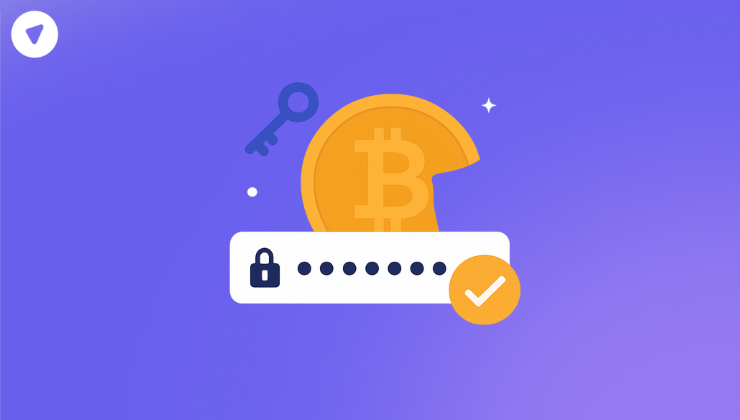Every 39 seconds, a cyberattack happens somewhere on the web, and weak or stolen passwords are the weapon of choice in more than 80% of breaches. In a world where Bitcoin wallets, online banking, and enterprise SaaS logins share the same vulnerability, password management has gone from a personal concern to a critical business necessity.
Enterprises and individual users alike face the same dilemma: how do you secure something that’s easy to forget, easy to reuse, and easy to steal? The answer lies in robust, scalable password management strategies that protect assets across every digital frontier.
Why Passwords Are Still the Front Door to Your Assets

- 70% of people reuse the same password across multiple accounts.
- Cybercriminals don’t need to break in—they just log in with stolen credentials.
- Crypto wallets and financial systems are especially at risk due to irreversible transactions.
For businesses, a single compromised password doesn’t just mean account takeover—it can translate into financial loss, reputational damage, and regulatory scrutiny.
The Expanding Attack Surface in 2025
As organizations scale, the number of accounts, apps, and endpoints explodes. Remote teams, SaaS sprawl, and crypto integrations mean IT managers have more digital keys to protect than ever before.
- Average enterprise uses 130+ SaaS applications.
- Remote work has increased phishing-related password theft attempts by over 60%.
- Cryptocurrency adoption is expected to reach 1 billion users by 2030, with wallets becoming prime targets.
With attack vectors multiplying, businesses cannot afford to rely on sticky notes, spreadsheets, or siloed password storage solutions.
Crypto Wallets, Credit Cards, and Cloud Apps: A Shared Risk
While the platforms differ—crypto exchanges, e-commerce portals, or enterprise dashboards—the vulnerabilities converge:
- Crypto Wallets: Private keys and seed phrases are often mishandled or stored insecurely.
- Credit Cards: Payment fraud costs businesses over $40 billion annually.
- Cloud & SaaS Tools: Shared credentials among remote teams increase exposure.
In every case, the weakness stems not from the technology itself, but from human error and poor credential management.
What Businesses Often Get Wrong About Password Security

Despite the rising stakes, many organizations fall into predictable traps:
- Overreliance on Password Policies: Complex rules don’t stop employees from writing passwords on sticky notes.
- Ignoring Integration Needs: Password managers that don’t integrate with Single Sign-On (SSO) or directory services lead to shadow IT.
Lack of Auditability: Without logs, it’s impossible to trace credential misuse.
This gap between perceived security and actual practices makes businesses ripe targets.
Cost of Inaction vs. Cost of Implementation
A frequent pushback from leadership is cost. But the numbers make the case clear:
| Factor | Without Password Management | With Password Management |
| Average Breach Cost | $4.45M | Significantly reduced risk |
| Employee Productivity Loss | 20–30 hours/year per user | Automated logins save time |
| Credential Sharing Risks | High | Controlled, auditable access |
| Integration with IT Systems | Manual, error-prone | Centralized & seamless |
The ROI isn’t just about avoiding breaches—it’s also about operational efficiency.
Technical Considerations for CTOs and Developers
Choosing the right password management solution involves more than user convenience. Here’s what technical leaders should weigh:
- API & SDK Availability: Critical for embedding password management into custom workflows.
- Encryption Protocols: End-to-end AES-256 encryption ensures even the provider can’t access credentials.
- Scalability: Ability to support both SMBs and enterprises as user counts grow.
- Zero-Knowledge Architecture: Ensures only users, not the vendor, hold the keys to data.
- Multi-Device Sync: Especially vital for remote and hybrid workforces.
Failure to prioritize these considerations can lead to integration nightmares and security gaps.
Password Management in the Age of Remote Work
Remote teams create a new set of vulnerabilities:
- Employees often log in from unsecured networks.
- Shared credentials for tools like CRM or project management systems are passed through chat apps or emails.
- Onboarding and offboarding become risks when accounts aren’t centrally managed.
Password managers not only secure credentials but also streamline employee lifecycle management—granting or revoking access in seconds.
The Future Outlook: Beyond Passwords

While passkeys, biometrics, and passwordless logins are gaining ground, the reality is clear: passwords aren’t disappearing anytime soon.
- By 2027, 50% of businesses will adopt some form of passwordless authentication.
Yet, legacy systems and cross-border teams will continue to depend on passwords for years to come.
Password managers bridge this transition—supporting existing credentials while preparing organizations for the next wave of authentication technology.
Why PureVPN White Label Password Manager Fits the Bill
When it comes to securing digital identities across wallets, cards, and apps, PureVPN White Label Password Manager offers a practical, business-ready solution.
Key Advantages for Businesses:
- Military-Grade Encryption: Protects crypto keys, financial data, and logins from end to end.
- Cross-Platform Access: Securely sync across desktops, mobiles, and browsers.
- Team Management Features: Share credentials safely with role-based controls.
- Audit Trails: Monitor who accessed what, and when.
- Seamless Integration: API-friendly for IT teams that need customization.
By combining security with usability, it eliminates the common friction points that lead to shadow IT or weak workarounds.
Actionable Takeaways for Businesses
- Don’t underestimate the universality of password risks—from Bitcoin wallets to billing systems.
- Calculate the cost of inaction; password management pays for itself in breach prevention and productivity gains.
- Prioritize solutions that scale, integrate, and provide transparency for IT leaders.
- Use password managers as a stepping stone toward future passwordless ecosystems.
Conclusion: Security Everywhere, All the Time
In today’s hyperconnected world, every login matters. Whether it’s a crypto wallet, a corporate SaaS tool, or a customer’s payment data, the weakest password can undo the strongest business strategy. By embracing password management as a core security layer, organizations aren’t just protecting assets—they’re enabling growth, trust, and resilience.


